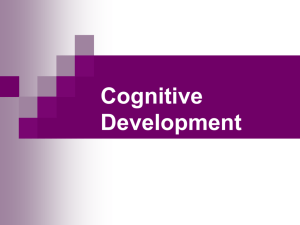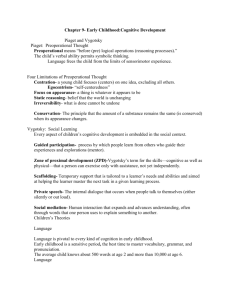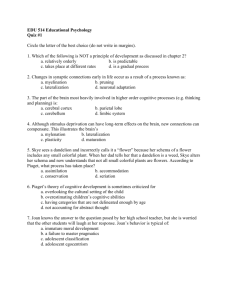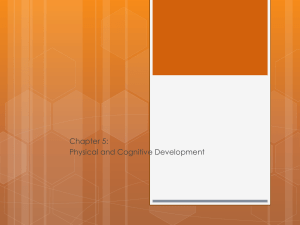Child Psychology Lecture 5 Cognitive Development
advertisement
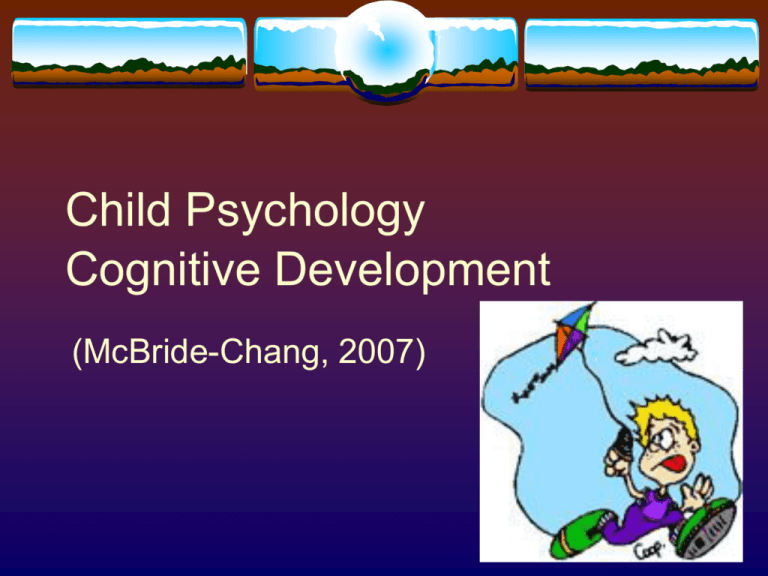
Child Psychology Cognitive Development (McBride-Chang, 2007) Outline 1. 2. 3. Piaget's theory of cognitive development and practical implications Information processing theory Overlapping Waves Model (Robert Siegler) Thought question: The HK Law Reform Commission recommends that the age of criminal responsibility be 10 years old. Currently, the age of criminal responsibility is 7 years of age. Is this change justified, given what you learn about cognitive development today? In other words, is 10 years of age too old, too young, or just right? 1) Piaget's theory of cognitive development constructivism Stages 1) Sensorimotor period (0-2 years) a)reflexes (0-1 month) b)primary circular reactions (1-4 months) c)secondary circular reactions (4-12 months) --coordination of 2ndary schemes d)tertiary circular reactions (12-18 months) e)representational thought (18-24 months) Stages 2) Preoperational period (2-7 years) Focus on conservation Preoperational thought is illogical in the following ways: a) Centering b) Egocentrism c) Irreversibility d) Appearance as reality Suggestions for teaching the preoperational child (Woolfolk, 1995) 1. Be concrete 2. Make instructions short and use actions to demonstrate Be sensitive to egocentrism 3. 4. 5. Clarify language Do hands-on learning Young children's play styles 1. Sensorimotor (12 months) 2. Constructive (after 12 months on) 3. First pretend (2nd year) 4. Substitute pretend (2-3 years on) 5. Sociodramatic (2-4 years on) Stages 3) Concrete operational period (7-12 years) Mastery of reversibility Inductive logic mastered Deductive logic poor 4) Formal operational thinking (adolescents and adults) --Abstract thinking mastered --If X is correct, y, z, and a should be observed (hypothetico-deductive reasoning) Age of criminal responsibility What age is appropriate? Facts China/Taiwan=14 Macau=16 HK: schooling until 15 HK: In sexual abuse cases, child=16 or younger Rehabilitation vs. criminalization Nevertheless, recommended age of criminal responsibility=10; actual legal age of criminal responsibility=7 Critique of Piaget's theory 1) 2) Over-focus on language explanations Some skills appear earlier than posited --theory of mind (3-5 years old) --gender constancy (4-5 years old) 3) Variabilities in performance 4) Culture (individualism) --Vygotsky's zone of proximal development --Scaffolding Conclusion First 3 “stages” of cognitive development occurs much more gradually (less stagelike) and earlier than Piaget assumed; adolescents perform less consistently hypothetico-deductively than originally postulated. List as many ways as you can to solve this problem. 5x10=? 2) Information processing theory A) Mental hardware--built-in mental and neural structures - speed - attention - memory B) Mental software-- specific knowledge - executive processes Theory of mind False belief A) Maturation B) Language C) Family experience 3) Overlapping Waves Model (Siegler) Assumption of variability, e.g., 1) Addition 2) Spelling 3) Infant locomotion 4) Conservation Strategic development depends upon Acquisition of new strategies Changes in frequency of existing strategies Changes in speed of execution of strategies Changes in accuracy of execution of strategies Changes in range of problems to which each strategy can be applied Strategy choice depends on Variability Adaptiveness Change Generalization to new situations Lessons learned Change is gradual. 2) Discoveries follow success as well as failure. 3) Early variability is related to later learning. 4) Discoveries are constrained by conceptual understanding. 1) The End! Very early, children --Can distinguish print from pictures and nonprint --Use visual cues to recognize first characters Better readers are --Faster --Better in language manipulation --Skilled at morphological awareness Developmental Concepts of Reading: Phonemic awareness, phonics, letter names, letter sounds (Bee, 2000; Berk, 2003; Feldman, 2004) To date, developmental textbooks assume that READING=READING ENGLISH Bronfenbrenner’s Ecological Approach Applied to Learning to Read Method of Child’s cognitive abilities language Phonological Awareness Awareness of and access to the sounds in language. In English, “fisp” without the /s/ is “fip.” In Chinese, Syllable 2000) awareness (e.g., McBride-Chang & Ho, Onset-rime (Huang & Hanley, 1995; 1997; Siok & Fletcher, 2001) Examples of levels of PA Syllable awareness: 大門口 (da4 men2 kou3) 大口 (da4 kou3) Onset-rime/phonemic awareness: tai-/t/ =ai Morphological Awareness Morpheme=smallest unit of meaning Morphological awareness--Awareness of and access to the meaning structure of language Simple compounding examples 人 (Ren) 車 (Che) 大人 (Adult) 火車 (Train) 女人 (Woman) 汽車 (Private Car) 外國人 (Foreigner) Cross-cultural measurement Chomsky: generativity,creativity, productivity occur across languages --Plantman for gardener--Clark, 1995 --”Genius comes from genie” Berko (1958): Wug/wugs; What do you call one who zibs? Why do you think a ___is called a ___? Our task, across cultures, requires that Children produce novel words by combining familiar morphemes in new ways, e.g., sunset/moonset; treetop/treebottom. Examples: 有一種家庭電器可以用來洗衣服,我們叫它洗衣機。 There is home appliance that uses to wash clothes, it is called a ‘washing machine’. 有一種新的家庭電器可以用來洗鞋,我們會怎麼叫 它呢?[洗鞋機]。 If that home appliance uses to wash shoes, what would you call that? (washing shoes machine) 有一種動物條頸好長既,叫做長頸鹿。 There is one animal that has a very long neck, we call that a giraffe. 咁如果呢種動物條頸好短,咁我地會叫佢做咩呢? [短頸鹿]。 If this animal’s neck has been shortened, what would you call that? (Giraffe with short neck) Cross-Cultural Issues Evolutionary primary abilities (Geary, 1995) --phonological awareness, morphological awareness, vocabulary: Language constructs may be “universals.” Evolutionary secondary abilities (reading) : For reading, it’s all relative. Cultures included in this study Beijing--Pinyin and Putonghua Hong Kong--No phonological coding system and Cantonese S. Korea--Clear phonological structure and much compounding U.S.--Clear need for phonemic awareness and less transparent morphological structure Conclusions Despite similar associations among language-related constructs, these constructs predict reading differently in different scripts--Morphological is important in Chinese and Korean; phonological awareness is important in English and Korean. These differences are specifically attributable to differences in scripts (and probably ultimately attributable to language differences as well. Why should you care? Theoretically, this theory of early reading growth accounts for observations of reading development across cultures better than do current conceptualizations as found in developmental textbooks. Theoretically, this theory fits well with notions of evolutionarily primary and secondary skills. Why else should you care? This conceptualization suggests that different remediation strategies for those low in reading skills may be in order depending upon culture/script to be learned. Practical implications: Morphological awareness may be particularly useful to develop and explicitly teach in Chinese and Korean for young children. Future Directions Longitudinal studies, particularly with children who initially cannot read Language & literacy study--early language and emergent literacy in Beijing and HK Intervention studies, based on previous intervention models in other areas: Early intervention is best.


